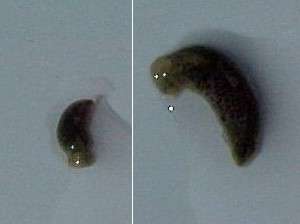Elysia from Texas
February 23, 2000
From: Cathy Porter

Bill;
We've been catching this organism in our 40 ft seine, in about 8 inches of water, in the Intracoastal Waterway, (a barge canal) [Texas, USA - Caribbean Coast], which receives water from a cut into Matagorda Bay. The cut is across the canal from our preserve, Mad Island Marsh Preserve (The Nature Conservancy, my employer). We've been seining at this location for 5 years now, sometimes twice a week, sometimes once a month. The salinity here has been about 27 ppt. We haven't noticed this critter until January, when we were routinely seining with a retired adults group. The critters survive in refrigeration for several weeks, and enjoy being in the sunlight.
However, we pulled the seine yesterday at the same location and didn't get any of these guys. we did get several mud snails. We viewed these guys with our microprojector, just in case our unknown critters were getting their shells crushed by the dredging operations ongoing in the ICWW. But, they're not the same organism.
I happened to plug in the words "marine nudibranch", and came up with David Behrens name and e-mail address. He seemed interested in the critter and wanted more information. Then he gave me your name.
Bill, our location is 2 hours from anywhere.
I'll let you know more details as I get them.
Sincerely,
Cathy
cwp@wcnet.net


Dear Cathy,
Firstly, although the World Wide Web does create the impression of a global village, the fauna and flora in the global village still changes from place to place. I'm afraid I still need to know where you are [what country, state etc] to give a sensible answer. I presume you are in Texas, USA as it is the only Intracoastal Waterway I have ever heard of but I could be quite wrong.
Your animal is almost certainly a sacoglossan, which are a group of herbivorous sea slugs. If you go to the Species List and look at some of the animals listed in the ORDER SACOGLOSSA you will get an idea of the diversity of these animals. From your sketch I suspect yours is a species of Elysia, but I would need local knowledge to be able to identify it to species.
Many sacoglossans have the interesting ability to keep chloroplasts, from the food they eat, alive in their bodies. They use the sugars produced in photosynthesis for their own nutrition. This could explain why yours seem to like the sunlight. See the page on Solar-powered sea-slugs for further information.
Thanks for the drawing. I presume your animal has a flap down each side of the body which is normally folded over to hide the ducts/veins you have drawn. These flaps are called the parapodia. The raised sac (which I have arrowed) is the renopericardial sac which contains the heart. The anus should open nearby. The network of ducts you have drawn are called 'the dorsal vessels' and their arrangement differs in different species. These ducts open into the pericardium and are filled with blood. Their function is uncertain but they are presumed to be involved with oxygen exchange and excretion.
Hopefully someone from your part of the world can help us with an identification.
Best wishes,
Bill Rudman.
May 2000: Identified by Kathe Jensen as Elysia chlorotica - see message.
Rudman, W.B., 2000 (Feb 23). Comment on Elysia from Texas by Cathy Porter. [Message in] Sea Slug Forum. Australian Museum, Sydney. Available from http://www.seaslugforum.net/find/1901Related messages
-
Lateral gene transfer between multicellular organisms
From: Bill Rudman, August 15, 2007 -
Elysia chlorotica "ghosts".
From: Skip Pierce, June 15, 2005 -
Elysia chlorotica from Martha's Vineyard, USA
From: skip pierce, May 14, 2005 -
Elysia anatomy
From: Kathleen Archer, November 13, 2003 -
New Paper on Elysia chlorotica
From: Elizabeth J. Summer, September 22, 2000 -
Trouble finding Elysia chlorotica
From: Jack Teng, August 4, 2000 -
Re: Elysia chlorotica & mating chains
From: Kathe R. Jensen, May 18, 2000 -
Elysia chlorotica & mating chains
From: Liz Summer, May 17, 2000 -
Re: Elysia sp. 7 from Texas
From: Kathe R. Jensen, May 7, 2000 -
Solar-powered Elysia chlorotica
From: Liz Summer, February 26, 2000
